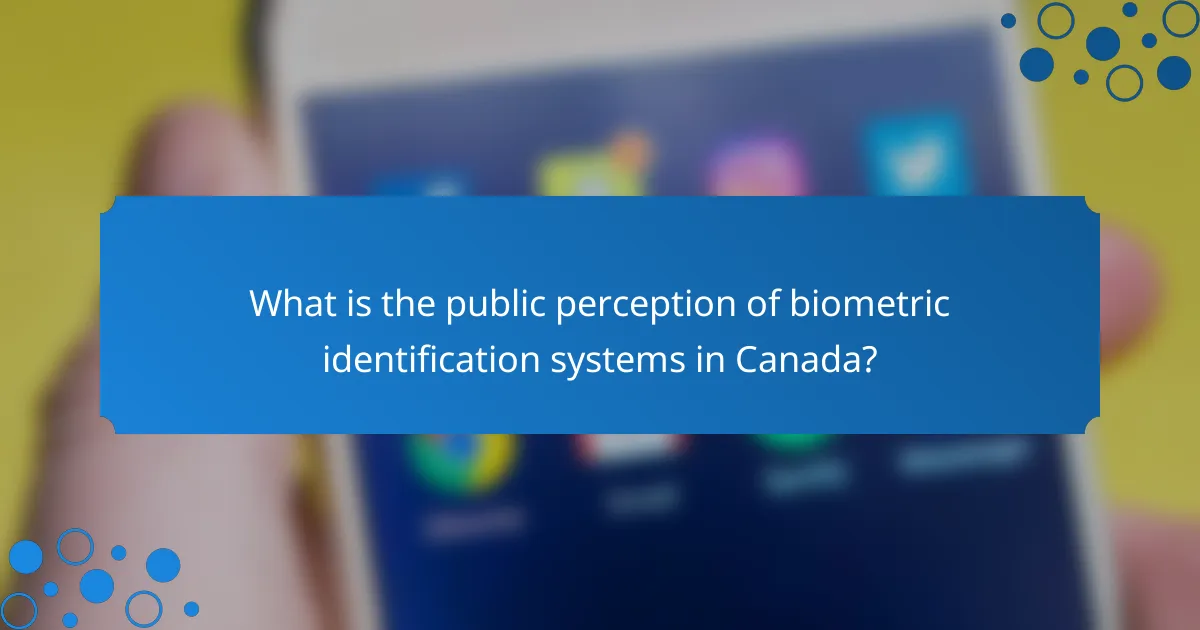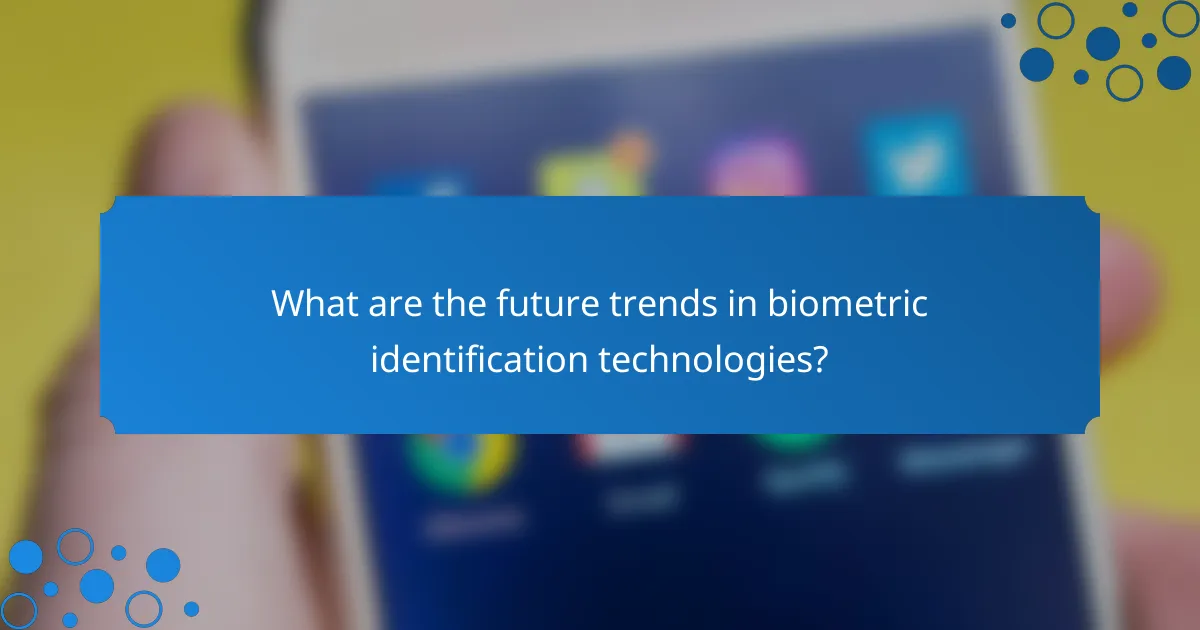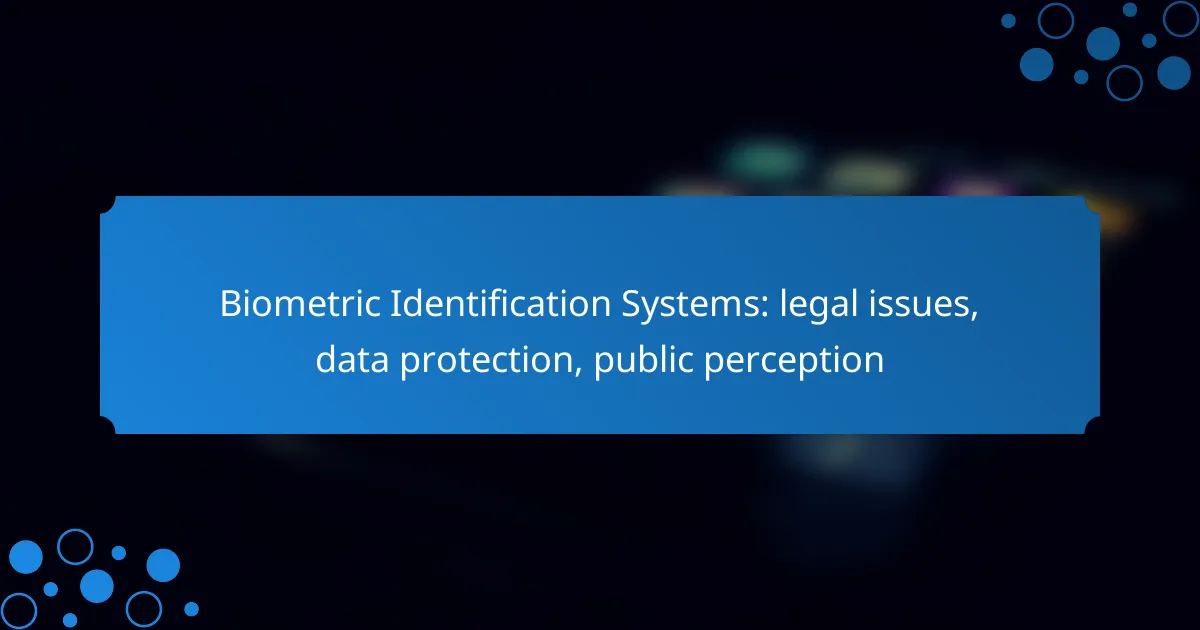Biometric identification systems are increasingly utilized in Canada, raising significant legal issues related to privacy, human rights, and regulatory compliance. While these systems employ advanced data protection techniques to safeguard personal information, public perception remains divided, with some individuals embracing the technology for its security benefits, while others voice concerns over privacy and surveillance risks.

What are the legal issues surrounding biometric identification systems in Canada?
Biometric identification systems in Canada face several legal issues, primarily related to privacy, human rights, and regulatory compliance. These systems must navigate complex legal frameworks to ensure they protect individual rights while serving public safety and security interests.
Privacy Act compliance
The Privacy Act governs how federal government institutions handle personal information, including biometric data. Organizations must obtain consent before collecting biometric data and ensure that it is stored securely and used only for the intended purposes.
Failure to comply with the Privacy Act can result in significant penalties and damage to public trust. Organizations should regularly review their data handling practices to ensure they align with legal requirements.
Human Rights considerations
Biometric identification systems can raise human rights concerns, particularly regarding discrimination and surveillance. The Canadian Charter of Rights and Freedoms protects individuals from unreasonable search and seizure, which can be implicated in biometric data collection.
Organizations must assess the impact of their biometric systems on vulnerable populations to avoid exacerbating existing inequalities. Implementing measures to ensure fairness and transparency is essential.
Regulatory frameworks
Various regulatory frameworks govern biometric identification in Canada, including the Personal Information Protection and Electronic Documents Act (PIPEDA). These regulations require organizations to implement strict data protection measures and provide individuals with access to their personal information.
Organizations should stay informed about changes in regulations and adapt their practices accordingly to maintain compliance and protect user data.
Case law examples
Canadian case law has begun to address the legal implications of biometric identification. For instance, the Supreme Court’s decision in R v. Spencer highlighted the importance of privacy rights in the context of digital data collection.
Organizations should study relevant case law to understand how courts interpret privacy and data protection issues, as these precedents can influence future legal standards and practices in biometric identification systems.

How do biometric identification systems ensure data protection?
Biometric identification systems ensure data protection through various techniques that safeguard personal data from unauthorized access and breaches. These methods include encryption, data anonymization, and strict access control measures, all designed to maintain user privacy and comply with legal standards.
Encryption methods
Encryption is a critical component in protecting biometric data, converting it into a format that is unreadable without a specific key. Common encryption standards, such as AES (Advanced Encryption Standard), are often employed to secure biometric information both at rest and in transit. This means that even if data is intercepted, it remains protected from unauthorized access.
Organizations must regularly update their encryption protocols to counter evolving threats. Using strong, complex keys and implementing multi-factor authentication can further enhance the security of biometric data.
Data anonymization techniques
Data anonymization involves altering biometric data so that individuals cannot be identified from it. Techniques such as hashing or tokenization can be used to replace sensitive information with non-identifiable equivalents. This process helps reduce the risk of privacy violations while still allowing for data analysis.
Implementing robust anonymization techniques is essential, especially in compliance with regulations like the GDPR in Europe, which emphasizes the protection of personal data. Organizations should regularly assess their anonymization methods to ensure they remain effective against potential re-identification threats.
Access control measures
Access control measures are vital for protecting biometric data from unauthorized users. These measures include role-based access controls (RBAC), which limit data access based on user roles within an organization. This ensures that only authorized personnel can access sensitive biometric information.
Regular audits and monitoring of access logs can help organizations identify and respond to unauthorized access attempts. Additionally, employing strong password policies and biometric authentication for system access can further strengthen security protocols.

What is the public perception of biometric identification systems in Canada?
The public perception of biometric identification systems in Canada is generally mixed, with many individuals expressing both trust and skepticism. While some see the technology as a means to enhance security and convenience, others raise concerns about privacy and surveillance implications.
Surveys on public trust
Surveys indicate that a significant portion of Canadians are open to biometric identification, particularly for purposes like border security and banking. However, trust varies widely based on the context of use; for instance, acceptance tends to be higher in controlled environments compared to public surveillance applications. Recent studies show that trust levels can fluctuate, with many respondents favoring transparency and clear regulations.
Concerns about surveillance
Many Canadians are apprehensive about the potential for biometric identification systems to enable mass surveillance. Concerns center around the misuse of data, lack of consent, and the possibility of government overreach. These fears are often amplified by high-profile cases of data breaches and discussions about state surveillance practices.
Impact of media coverage
Media coverage plays a crucial role in shaping public perception of biometric identification systems. Positive stories highlighting successful implementations can boost trust, while negative reports about privacy violations or technical failures can lead to increased skepticism. The framing of these stories often influences public opinion, making it essential for stakeholders to engage proactively with media narratives.

What are the implications of biometric data breaches?
Biometric data breaches can lead to severe consequences, including legal repercussions and damage to an organization’s reputation. The sensitive nature of biometric information, such as fingerprints or facial recognition data, makes its exposure particularly harmful.
Legal consequences
Organizations that experience biometric data breaches may face legal action under various data protection laws. For instance, in the European Union, the General Data Protection Regulation (GDPR) imposes hefty fines for non-compliance, which can reach up to 4% of annual global revenue or €20 million, whichever is higher.
In the United States, states like Illinois have specific laws governing biometric data, such as the Biometric Information Privacy Act (BIPA), which allows individuals to sue for damages. Legal consequences can include not only fines but also class-action lawsuits and increased regulatory scrutiny.
Reputational damage
The fallout from a biometric data breach can severely tarnish an organization’s reputation. Customers expect their biometric data to be handled with the utmost care; a breach can lead to a loss of trust and customer loyalty. This can result in decreased sales and a negative public perception that may take years to repair.
Moreover, companies may find themselves facing increased scrutiny from media and advocacy groups, further amplifying the reputational damage. Organizations should proactively communicate their data protection measures and response strategies to mitigate the impact of any potential breaches.

What frameworks exist for evaluating biometric systems?
Several frameworks are available for evaluating biometric systems, focusing on risk assessment and compliance. These frameworks help organizations ensure that biometric implementations are secure, legally compliant, and aligned with public expectations.
Risk assessment models
Risk assessment models for biometric systems involve identifying potential vulnerabilities and evaluating the impact of these risks. Common models include qualitative assessments, where risks are categorized based on likelihood and impact, and quantitative assessments, which may involve numerical scoring systems.
Organizations should consider factors such as data sensitivity, user consent, and potential misuse when applying these models. For example, a biometric system storing sensitive personal data may require a more rigorous assessment compared to one with less sensitive information.
Compliance checklists
Compliance checklists serve as practical tools for ensuring that biometric systems adhere to relevant laws and regulations. These checklists typically cover aspects such as user consent, data protection measures, and transparency in data usage.
When creating a compliance checklist, organizations should reference applicable regulations like the General Data Protection Regulation (GDPR) in Europe or the California Consumer Privacy Act (CCPA) in the United States. A well-structured checklist can help identify gaps in compliance and guide necessary adjustments to the biometric system.

What are the future trends in biometric identification technologies?
Future trends in biometric identification technologies include increased integration with artificial intelligence, enhanced security measures, and broader applications across various sectors. These advancements aim to improve accuracy, efficiency, and user experience while addressing privacy concerns.
Integration with AI
Integrating AI with biometric identification technologies enhances their capabilities significantly. AI algorithms can analyze biometric data more efficiently, leading to faster identification and improved accuracy in recognizing patterns and anomalies.
For example, facial recognition systems powered by AI can adapt to changes in appearance over time, such as aging or changes in hairstyle. This adaptability is crucial for maintaining the effectiveness of biometric systems in real-world applications.
However, organizations should remain cautious about the ethical implications of AI integration. Ensuring transparency in how biometric data is used and maintaining user consent are essential to foster public trust and compliance with regulations.
